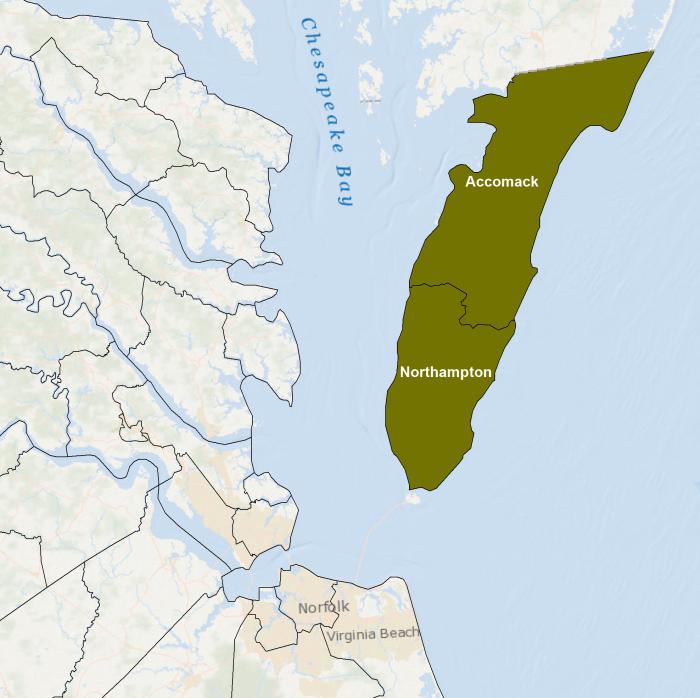
The American black duck is a state-identified target species of the Working Lands for Wildlife (WLFW) partnership, a collaborative approach to conserve habitat on working lands. NRCS offers assistance to help reverse population declines due to loss of coastal habitats.
On This Page
State Program Overview
Virginia is one of four states participating in this partnership initiative launched in Fiscal Year 2017 to help reverse species decline by reducing threats to critical habitat. Eligible agricultural producers in Delaware, Maryland, Virginia and New Jersey can receive help with implementing a variety of conservation practices to support habitat development and invasive species control in the Mid-Atlantic region’s Delaware Bay and Chesapeake Bay watersheds. Funding is available for landowners in Accomack and Northampton counties who are interested in helping to restore black duck wintering habitat in the Chesapeake Bay Watershed (see map below).

Available Practices
The following practices are being offered in Virginia to protect, restore and create emergent wetland and forested wetland habitat, manage invasive plants and combat habitat loss due to development, pollution and wetland conversion:
- 314 - Brush Management
- 327 - Conservation Cover
- 342 - Critical Area Planting
- 356 - Dike
- 394 - Firebreak
- 315 - Herbaceous Weed Control
- 484 - Mulching
- 378 - Pond
- 338 - Prescribed Burning
- 643 - Restoration and Management of Rare and Declining Habitats
- 391 - Riparian Forest Buffer
- 390 - Riparian Herbaceous Cover
- 646 - Shallow Water Development/Management
- 587 - Structure for Water Control
- 649 - Structures for Wildlife
- 612 - Tree/Shrub Establishment
- 645 - Upland Wildlife Habitat Management
- 658 - Wetland Creation
- 659 - Wetland Enhancement
- 657 - Wetland Restoration
- 644 - Wetland Wildlife Habitat Management
- 420 - Wildlife Habitat Planting
Outcomes and Impacts
Landowners will use conservation practices to restore habitat for the black duck in coastal estuaries and tidal waters. Anticipated outcomes of WLFW efforts include healthy coastal habitats, increased food availability in the Mid-Atlantic region, and the stabilization or recovery of black duck populations. These efforts will also directly or indirectly benefit the northern pintail, wood duck, redhead, green-winged teal, hooded merganser, canvasback and more than 25 other species.
State Contacts:
Jeff Jones, State Biologist
PH: 804-287-1636 | Email: jeffray.jones@usda.gov
Jenny Templeton, Accomac District Conservationist
PH: 757-302-4435 | Email: jennifer.templeton@usda.gov
Ready to get started?
Contact your local service center to start your application.
How to Get Assistance
Do you farm or ranch and want to make improvements to the land that you own or lease?
Natural Resources Conservation Service offers technical and financial assistance to help farmers, ranchers and forest landowners.

To get started with NRCS, we recommend you stop by your local NRCS field office. We’ll discuss your vision for your land.
NRCS provides landowners with free technical assistance, or advice, for their land. Common technical assistance includes: resource assessment, practice design and resource monitoring. Your conservation planner will help you determine if financial assistance is right for you.
We’ll walk you through the application process. To get started on applying for financial assistance, we’ll work with you:
- To fill out an AD 1026, which ensures a conservation plan is in place before lands with highly erodible soils are farmed. It also ensures that identified wetland areas are protected.
- To meet other eligibility certifications.
Once complete, we’ll work with you on the application, or CPA 1200.
Applications for most programs are accepted on a continuous basis, but they’re considered for funding in different ranking periods. Be sure to ask your local NRCS district conservationist about the deadline for the ranking period to ensure you turn in your application in time.
As part of the application process, we’ll check to see if you are eligible. To do this, you’ll need to bring:
- An official tax ID (Social Security number or an employer ID)
- A property deed or lease agreement to show you have control of the property; and
- A farm number.
If you don’t have a farm number, you can get one from USDA’s Farm Service Agency. Typically, the local FSA office is located in the same building as the local NRCS office. You only need a farm number if you’re interested in financial assistance.
NRCS will take a look at the applications and rank them according to local resource concerns, the amount of conservation benefits the work will provide and the needs of applicants. View Application Ranking Dates by State.
If you’re selected, you can choose whether to sign the contract for the work to be done.
Once you sign the contract, you’ll be provided standards and specifications for completing the practice or practices, and then you will have a specified amount of time to implement. Once the work is implemented and inspected, you’ll be paid the rate of compensation for the work if it meets NRCS standards and specifications.

